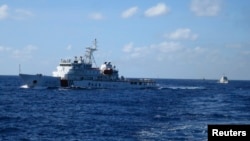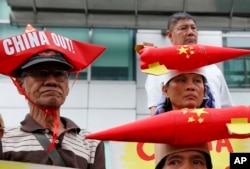Beijing has stationed its first permanent search and rescue ship in a hotly disputed part of the South China Sea as a public relations move after alarming smaller countries with a military buildup in the same waters, analysts say.
The Ministry of Transport in China sent the vessel, called South Sea Rescue 115, to the Spratly Islands on July 27, the official Xinhua News Agency said. The vessel can work in storm gales and waves up to six meters high, according to Xinhua. It’s also equipped with a helicopter pad. More such vessels will be built, the agency added.
The ministry’s Rescue and Salvage Bureau will “consistently improve its standby mechanism in the South China Sea region to better carry out maritime rescue duties and obligations under international treaties,” bureau head Wang Zhenliang said as quoted by Xinhua.
China may have sent and publicized this vessel’s deployment to look good after angering other states over militarization, experts say.
“The whole thing about making big announcements about like having a humanitarian activity is kind of just trying to put a friendly veneer on top of what is pretty clearly militarization and just trying to kind of like brainwash,” said Jonathan Spangler, director of the South China Sea Think Tank in Taipei.
Military buildup
Brunei, Malaysia, the Philippines, Taiwan and Vietnam contest all or part of Beijing’s claims to about 90 percent of the South China Sea including the Spratly Islands. The sea, which covers 3.5 million square kilometers, is prized for fisheries, oil, natural gas and shipping lanes.
China cites historical records to support its claims. Over the past decade it has used landfill to expand some of the sea’s tiny islets. That expansion, followed in some cases by military installations, irritates other claimants as China has the region’s strongest armed forces.
“China might try and sort of take the heat off the military function by publicizing the search and rescue function, but I don’t think that’s really going to alter perceptions,” said Euan Graham, international security director with the Lowy Institute for International Policy in Sydney.
“There is a sort of PR war going on, but I think China’s ability to win that PR war is much less than it was a few years ago just because I think the military dimension has become more open, more difficult to hide,” he said.
Chinese military vessels and aircraft preceded the search-and-rescue vessel, he noted, so China is putting its “cart before the horse.”
Other countries offering aid
Beijing may hope its search-and-rescue ship will help it catch up to other governments, analysts believe.
Chinese political rival Taiwan does search and rescue work from its base at Taiping Island, the largest in the Spratly chain. A Taiwanese coast guard official said in 2015 his agency had rescued non-Taiwanese fishermen from storms in the Spratlys.
Last year, Australian troops did a disaster relief exercise with the Philippines in a bay along the South China Sea.
And Japan’s Izumo-class helicopter-carrying warship can do humanitarian work as well as rescues, said Collin Koh, maritime security research fellow at Nanyang Technological University in Singapore. Japan sent the ship into the South China Sea in mid-2017.
Australia and Japan do not claim any part of the sea but oppose any exclusive use of it by China.
Philippines watching
In the Philippines, which holds nine islets in the Spratly chain, policymakers may see the search-and-rescue vessel as a dubious though overdue gesture, said Maria Ela Atienza, political science professor at the University of the Philippines Diliman.
The two countries have gotten along over the past two years, but the Philippine Star news website said in May China had set a "red line" with the Philippines, saying uninhabited islets should stay that way.
China “could play a bigger role in the region” when civilians are hurt, Atienza said. Filipinos scorned China for perceived lack of aid after Typhoon Yolanda killed more than 6,000 people in the Philippines in 2013, she said.
“From a diplomatic perspective, it can be considered good neighborly action,” Atienza said. “(China) has not played that kind of a role in recent cases where rescue operations are needed.”
Economic aid
Beijing has been particularly image conscious since 2016, when it lost a world arbitration court verdict over the legal basis for its South China Sea claims.
China rejected the verdict but began building up relations after that with the Southeast Asian maritime claimants by offering development aid and investment in infrastructure construction. China commands the world’s second largest economy, dwarfing those of Southeast Asia.
Countries with “greater power” and China’s level of resources also have a greater responsibility to offer humanitarian aid, Spangler said.









